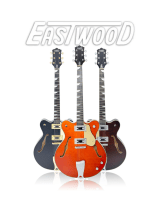Page is loading ...


WARREN ELLIS SIGNATURE MANDOSTANG SET-UP GUIDE
Congratulations on your purchase, and welcome to the Eastwood family!
All Eastwood® Guitars are fitted with high-quality modern components that offer an optimal playing
experience that far exceeds their 1960's original counterparts. It is hard to find a guitar these days that
oozes more vintage style than an Eastwood®!
Please refer to the following guide when setting up your new Warren Ellis Mandostang to factory
settings. This guide is intended for the Warren Ellis Mandostang model.
NECK RELIEF: This refers to the amount of bow that exists in the neck, and should always be the first
step when setting up your instrument. All Eastwood and Airline truss rods are designed for use with a
4mm hex wrench or Allen key. With a capo holding down the strings at the first fret, push down the low
(thickest) string in the 15th fret. Look at the gap between the top of the 7th fret and the bottom of the
string you are holding down - the string should just barely be passing over the fret. If you can fit
anything more than a piece of cardstock through here, then there is too much relief in the neck (Fig. B)
and you will need to turn the truss rod clockwise to flatten it out. If the strings are touching the fret, (or
you a’t fit that piee of ardstok through the gap) the the neck is bowed backward (Fig. C) and you
will need to turn the truss rod counter-clockwise to add relief. Try to turn the key in small increments,
and check the neck after each adjustment. DO NOT attempt the adjustment if you are not comfortable
doing so, as you can potentially cause damage. Bring the guitar to a trained professional instead.

ACTION: The atio of a guitar refers to the distance between the bottom of your strings and the top
of your frets. After your neck has been set properly, you can further adjust this distance by raising or
lowering each saddle using a 1.5mm hex wrench or Allen key. Measure the distance between the
bottom of the Low G (thickest) string and the top of the 12th fret. Set it so that this distance is ~4/64".
Measure the distance between the bottom of the High E (thinnest) string and the top of the 12th fret.
Set it so that this distance is just slightly lower than your low string. Next, set your A and D strings so
that they are slightly higher than the G and E – the idea here is to follow the radius of the fingerboard as
best you can. From here you can make minor tweaks until the strings are at a height that is comfortable
for your playing.
INTONATION: This refers to the fine-tuning of your Mandostang. A properly intonated instrument is one
that sounds in tune across the entire neck. This should be your last step of the set-up, as raising your
strings or changing your neck bow can have a drastic effect on your intonation. Using a tuner, make sure
all your strings are in tune first. Check your intonation one string at a time beginning with the Low
(thickest) string. This string should read the same pitch when played open as when played in the 12th
fret. If it is flat, you will need to make the string shorter by moving the saddle towards the pickups. If the
note is sharp, make the string longer by moving the saddle away from the pickups. Be sure to re-tune
the string after each adjustment.
PICKUP HEIGHT: This refers to the distance between the bottom of your strings and the top of the blade
in the pickup. These should be set properly so that your strings have equal output, and the guitar's tone
is represented as it should. That said, the following measurements are guidelines only, and you should

experiment with different heights to achieve a tone you are happy with. Hold down your Low (thickest)
string at the last fret, and measure the distance between the bottom of the string and the top of the
blade in the pickup. Do the same with the High (thinnest) string. Aim for measurements similar to:
Distance at neck pickup: ~ 3/”
FINAL NOTES: Keep i id that if you’e put a e set of strigs o, it may take a little time for them
to get used to their new tension. You can help speed this process up by giving them a good stretching
before tuning them to pith. All that’s left to do o is polish it up, plug it i, ad play!
If you’re usure aout aythig i this guide, please otat us at
support@eastwoodguitars.com for
further assistance. As always, please see a trained professional if you are uncomfortable making any of
these adjustments yourself.
©Eastwood Guitars INC.
/





